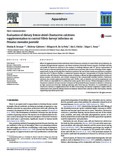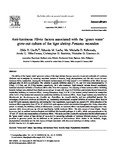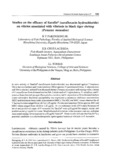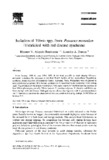Evaluation of dietary freeze-dried Chaetoceros calcitrans supplementation to control Vibrio harveyi infection on Penaeus monodon juvenile

View/
Request this document
Date
2014Page views
218Metadata
Show full item recordCited times in Scopus
Share
Abstract
Effects of supplementation of diets with freeze-dried Chaetoceros calcitrans to control Vibrio harveyi infection are evaluated through immune responses, and disease resistance of juvenile Penaeus monodon. Total lipid and fatty acid profile of Chaetoceros calcitrans is also analyzed. A challenge infection with 107 cfu/mL concentration of Vibrio harveyi is intramuscularly injected to juvenile Penaeus monodon after 45 days of feeding of diets supplemented with 15 g/kg and 30 g/kg dried Chaetoceros calcitrans. The use of dried Chaetoceros calcitrans is compared with that of ß-1,3 glucan Curdlan, a commercial immune enhancer. Incorporation of 30 g/kg Chaetoceros calcitrans in the diet enhances the immune system of shrimp as effected by high prophenoloxidase activity and plasma protein concentration and is better compared to the commercially available Curdlan. Chaetoceros calcitrans also contains polyunsaturated fatty acids (PUFAs) such as linolenic acid and eicosapentanoic acid (EPA) which are responsible for its antibacterial action against Vibrio harveyi. All these biological activities of Chaetoceros calcitrans add up to increase resistance of the juvenile Penaeus monodon to vibriosis as shown by its high survival rate from the challenge infection with Vibrio harveyi. Therefore, it is worthwhile to use Chaetoceros calcitrans as supplementary feed. Its effect in increasing the immune competence coupled with its antibacterial action, make the shrimp resistant to luminous vibriosis that continues to affect the industry, thereby augmenting aquaculture production.
Keywords
Luminous vibriosis Chaetoceros calcitrans Vibrio harveyi Penaeid shrimp Immunostimulant Antibacterial activitySuggested Citation
Seraspe, E. B., Gabotero, S., de la Peña, M. R., Pahila, I. G., & Amar, E. (2014). Evaluation of dietary freeze-dried Chaetoceros calcitrans supplementation to control Vibrio harveyi infection on Penaeus monodon juvenile. Aquaculture , 432, 212-216. https://doi.org/10.1016/j.aquaculture.2014.04.040
Subject
vibriosis  ; diet
; diet  ; pathogenic bacteria
; pathogenic bacteria  ; shrimp culture
; shrimp culture  ; fatty acids
; fatty acids  ; feeding experiments
; feeding experiments  ; mariculture; antibiotics
; mariculture; antibiotics  ; feed composition
; feed composition  ; feeding
; feeding  ; linolenic acid; immune system; lipids
; linolenic acid; immune system; lipids  ; survival
; survival  ; disease resistance
; disease resistance  ; infectious diseases
; infectious diseases  ; aquaculture
; aquaculture  ; plasma proteins; dietary supplements; colonies
; plasma proteins; dietary supplements; colonies  ; polyunsaturated fatty acids
; polyunsaturated fatty acids  ; immunity
; immunity  ; glucans; Penaeus monodon
; glucans; Penaeus monodon  ; protein content
; protein content 
 ; diet
; diet  ; pathogenic bacteria
; pathogenic bacteria  ; shrimp culture
; shrimp culture  ; fatty acids
; fatty acids  ; feeding experiments
; feeding experiments  ; mariculture; antibiotics
; mariculture; antibiotics  ; feed composition
; feed composition  ; feeding
; feeding  ; linolenic acid; immune system; lipids
; linolenic acid; immune system; lipids  ; survival
; survival  ; disease resistance
; disease resistance  ; infectious diseases
; infectious diseases  ; aquaculture
; aquaculture  ; plasma proteins; dietary supplements; colonies
; plasma proteins; dietary supplements; colonies  ; polyunsaturated fatty acids
; polyunsaturated fatty acids  ; immunity
; immunity  ; glucans; Penaeus monodon
; glucans; Penaeus monodon  ; protein content
; protein content 
Taxonomic term
Collections
- AQD Journal Articles [1215]
Related items
Showing items related by title, author, creator and subject.
-
Anti-luminous Vibrio factors associated with the ‘green water’ grow-out culture of the tiger shrimp Penaeus monodon
Lio-Po, Gilda D.; Leaño, Eduardo M.; Peñaranda, Ma. Michelle D.; Villa-Franco, Annie U.; Sombito, Christopher D.; Guanzon, Nicholas G., Jr. (Elsevier, 2005)The ability of the “green water” grow-out culture of the tiger shrimp Penaeus monodon to prevent outbreaks of Luminous Vibriosis was investigated by screening associated isolates of bacteria, fungi, phytoplankton and fish ... -
Studies on the efficacy of Sarafin® (sarafloxacin hydrochloride) on vibrios associated with vibriosis in black tiger shrimp (Penaeus monodon)
Pakingking, Rolando V., Jr.; Lacierda, Erlinda; Torres, James L. (Fish Health Section, Asian Fisheries Society, 2002)In vitro activity of Sarafin® (sarafloxacin hydrochloride) was determined against 7 luminous Vibrio harveyi isolates and 3 non-luminous Vibrio species (V. parahaemolyticus, V. alginolyticus and Vibrio species) isolated ... -
Isolation of Vibrio spp. from Penaeus monodon (Fabricius) with red disease syndrome
Tendencia, Eleonor; Dureza, Lourdes A. (Elsevier, 1997)From January 1990 to June 1993, 59% of the total juvenile to adult shrimp Penaeus monodon submitted for diagnosis at the Fish Health Section of the Aquaculture Department, Southeast Asian Fisheries Development Center, ...




